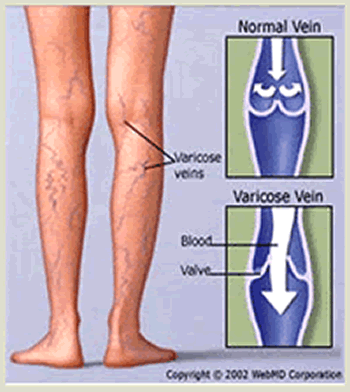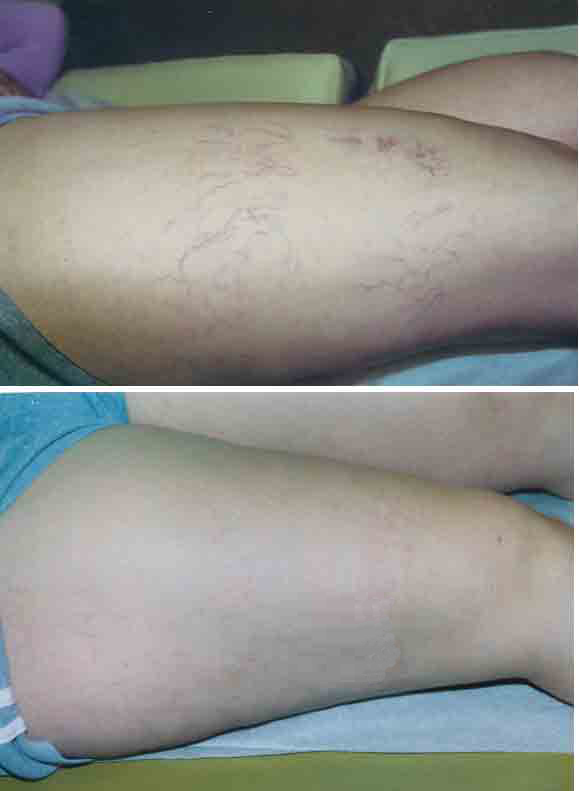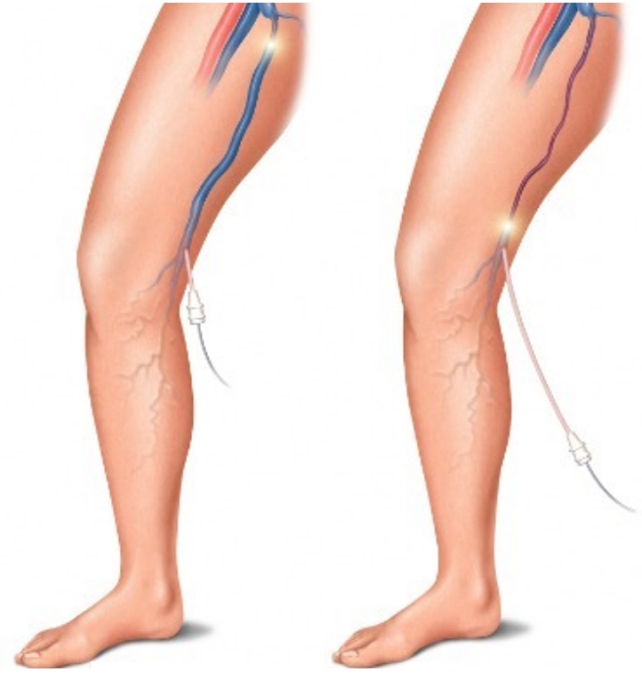Spider Vein and Varicose Veins
It is estimated that more than 80 million Americans suffer from some form of venous disorder leading to unsightly spider veins and varicose veins. Veins carry oxygen-depleted blood back to the heart. Veins use a unique process to return the blood from the extremities back to the heart where your muscles contract and squeeze the blood up through the veins and small valves prevent blood from flowing backwards. In a normal healthy situation the blood doesn't pool in the vein. It flows right through.
Spider veins and varicose veins are actually veins where the valves don't function well, the blood will not flow effectively back to the heart. The valves have stopped working and now blood falls backwards and pools inside the vein. This poor circulation causes the vein to become congested with blood and enlarged. These dysfunctional veins are commonly called spider veins or varicose veins. Patients can feel symptoms that are often associated with this bad circulation including pain, swelling, feelings of fatigue, heaviness, aching, burning, throbbing, itching, cramping.
Severe varicose veins can compromise the health of the skin and lead to eczema, inflammation or even ulcerations (wounds) of the lower leg. These symptoms are often made worse by prolonged standing or sitting.

Sclerotherapy - Spider Veins
 Sclerotherapy is the best treatment available for spider veins and reticular veins (remember these are the blue-green ones that run just underneath the surface of the skin, sometimes called feeder veins). It is a performed in staged short office visits, usually no more than 15-30 minutes. The patient can immediately resume their normal activity, including exercise. It requires no anesthesia and no post-treatment care, although some patients may be advised to wear compression hose for a week following treatment to enhance their results and reduce nuisance side effects.
Sclerotherapy is the best treatment available for spider veins and reticular veins (remember these are the blue-green ones that run just underneath the surface of the skin, sometimes called feeder veins). It is a performed in staged short office visits, usually no more than 15-30 minutes. The patient can immediately resume their normal activity, including exercise. It requires no anesthesia and no post-treatment care, although some patients may be advised to wear compression hose for a week following treatment to enhance their results and reduce nuisance side effects.
The procedures of Sclerotherapy requires a high level of expertise, especially for the smaller veins, but it is extremely safe when performed by a specialist in Phlebology. Most of our patients say the treatment is comfortable with no more pain than tweezing a hair.
A pioneer in the field, Dr. Robert has launched nine practices specialized in vein treatment and have performed over 1,650,000 treatments in his career. Dr. Robert is considered one of the top experts in the USA in Phlebology. He has lectured all over the world in the field and was a co-author on the definitive medical textbook - Vein Diagnosis and Treatment. He has trained over 100 clinicians in the USA and was on the Education committee of the American College of Phlebology.
Some laser companies have claimed outstanding results with laser treatment for spider and reticular veins. This is far from real case results achieved in true practice. In truth, laser treatment is the only safe and effective treatment for hemangiomas, and for very small facial spider veins, and for a select group of leg spider veins.
Endovenous Laser Treatment/Ablation (EVLT/EVLA) - Varicose Veins

Many varicose veins, the large ropy veins that worm their way under your skin, can cause pain and swelling. But what you see on the surface may be only the ripple. These veins may have a deeper cause with larger bad veins (such as the Greater Saphenous Vein or GSV).
Sclerotherapy alone may not work to close these veins. You need to treat the source. One of the safest, fastest, and most comfortable treatments for this is called Endovenous Laser Treatment (EVLT) or Endovenous Laser Ablation (EVLA).
Endovenous laser treatment is performed under local anesthesia in the doctor's office. There is little to no scarring and a relative short recovery period after the procedure.
it is an outpatient procedure, which means you can resume your normal activities almost immediately. This FDA approved treatment is only offered by very specialized centers. Under local anesthesia a laser fiber is threaded into the dysfunctional vein using ultrasound guidance to ensure placement of the fiber. Then the bad vein is closed using the laser heat to "zip" it up. There are no scars and you can resume your normal activity including exercise immediately.
The published success of EVLA treatment is between 95-98%, with far fewer complications than surgery such as ambulatory phlebectomy or vein stripping.
